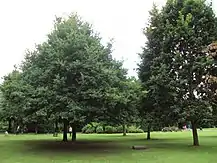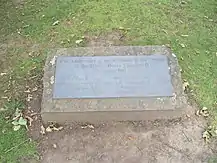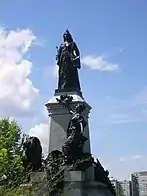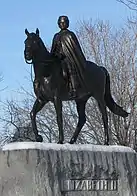Ruby Jubilee of Elizabeth II
The Ruby Jubilee of Elizabeth II in 1992 marked the 40th anniversary of the accession of Queen Elizabeth II to the thrones of the United Kingdom and other Commonwealth realms.[2][3] Contrary to her Silver Jubilee in 1977, there were no widespread public celebrations of the Ruby Jubilee; it was a low-profile event.[4] Also, The Queen did not undertake any official engagements. However, there were some observances to mark the milestone.

Ruby Jubilee Lunch and Annus Horribilis Speech

On 24 November 1992, a luncheon was held at the Guildhall, London to honour The Queen's Ruby Jubilee on the throne. The event was organised by the City of London Corporation and attended by more than 500 people including The Queen, The Duke of Edinburgh, The Lord Mayor and Lady Mayoress of London and Prime Minister John Major and his wife Norma Major. Donning a dark green dress and matching hat, The Queen delivered a 'historic' speech, in which she described the year 1992 as her annus horribilis (a Latin phrase meaning 'horrible year').[5] In that year, three of her children's marriages crumbled; a fire destroyed more than a hundred rooms in Windsor Castle; a toe-sucking scandal involving The Duchess of York,[6] and the publication of Andrew Morton's controversial book about The Princess of Wales called Diana: Her True Story caused a stir in Britain and the monarchy.[7] As a result, the public opinion turned against the Royal Family, and due to this, the jubilee celebrations were toned down.[8][9]
In addition to that, Mauritius, one of The Queen's realms, became a republic on 12 March;[10] on 22 October during a state visit to Germany, angry demonstrators in Dresden threw eggs at her,[11] and on 17 December, the Australian government of republican Paul Keating announced that the Queen would be dropped from the Australian citizenship oath.[12]
Commemoration
United Kingdom
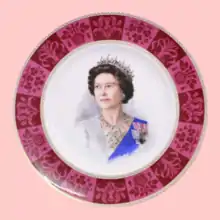
Different stamps and coins marking 40 years of Elizabeth II as Queen were released by the United Kingdom (including its Crown dependencies and Overseas territories), Commonwealth realms and some former realms of The Queen.
On the Accession Day of The Queen, Prime Minister John Major and the leader of the opposition Neil Kinnock gave statements of congratulations to The Queen for reaching the milestone, in the House of Commons.[13]
A banquet was hosted at Spencer House by Prime Minister John Major and former Prime Ministers Harold Wilson, Edward Heath, James Callaghan and Margaret Thatcher on 27 July 1992 to celebrate the 40th anniversary of The Queen's accession. The royal party that attended the banquet were The Queen, The Duke of Edinburgh and The Prince and Princess of Wales.[14][15]
The Great Event
A grand gala celebration of forty years of The Queen's reign, entitled 'The Great Event' , was held at London's Earl's Court on 26 October 1992. It was organized by the Royal Anniversary Trust[16] and televised throughout the world. The gala was attended by more than 1,700 people, including The Queen, The Duke of Edinburgh, The Prince and Princess of Wales, The Duke of York, Prince Edward, The Princess Margaret, The Duchess of Kent, Princess Michael of Kent, Prime Minister John Major, the leader of the opposition Labour Party, John Smith, the Secretary-General of the Commonwealth Chief Emeka Anyaoku, and the Archbishop of Canterbury, George Carey.[17] The programme included performances by Dame Vera Lynn, pop singer Cliff Richard and Lonnie Donegan. More than 500 children, who represented the nations of the Commonwealth, took part during the grand finale. They wore their indigenous dresses and arranged on the stage to form a map of the world.[17]
The Commonwealth Mace
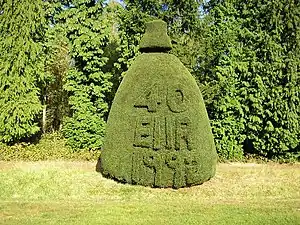
During 'The Great Event' at London's Earl's Court, The Queen was presented with a special Commonwealth Mace, which was proposed by the Royal Anniversary Trust and approved by the Commonwealth Heads of Government at Harare Commonwealth Heads of Government Meeting in 1991, to mark the 40th anniversary of The Queen's accession to the throne. The Queen also received fifty-two silver gilt toasting goblets, one for each of the then members of the Commonwealth. The mace itself was designed by the London-based goldsmith Gerald Benney.[18] The Commonwealth Mace contains five kilograms of 18 carat gold, rubies, and is illustrated with the Royal Coat of Arms, the Commonwealth Symbol, and the emamelled flags of the member states of the Commonwealth.[19] Geoffrey Munn, an antiques expert, described it as a “most marvellous tribute to her majesty’s reign and a lovely thing to see.”[20]
Elizabeth R: A Year in the Life of the Queen
A documentary film, named Elizabeth R: A Year in the Life of the Queen was made by the BBC to mark the 40th anniversary of the Queen's accession.[21] The Royal family watched and approved of the documentary before it was broadcast on television.[22] The film aired on 6 February 1992, the 40th Accession Day of the Queen, and it was also broadcast in more than 25 countries around the world.[23] It gained the largest audience for a documentary in the history of British television and was watched by more than half of the British population in 1992.[24]
Canada
An equestrian sculpture of the Queen was commissioned in 1990 in order to commemorate the Ruby Jubilee and the 125th anniversary of Confederation in 1992.[25] The statue was unveiled on 30 June 1992 during the Queen's 1992 Royal tour of Canada, which took place until 3 July.[25] The statue was unveiled on the grounds of Parliament Hill, situated across a statue of Queen Victoria, the first monarch of a confederated Canada.[25]
The Queen undertook the royal tour in order to preside over several commemorations relating to the 125th anniversary of Canadian Confederation and her Ruby Jubilee.[25] On the same day she unveiled her equestrian statue, the Queen also unveiled two stained-glass windows at Rideau Hall, one to commemorate her Ruby Jubilee, the other to commemorate the 40th anniversary of the appointment of the first Canadian-born governor general of Canada. She also presented new colours to her regiment, the Canadian Grenadier Guards.[25] The following day, she presided over the swearing in of new members for the Queen's Privy Council of Canada, before presiding over official Canada Day celebrations on Parliament Hill.[25]
During the year, the Parliament of Canada also passed a motion of congratulations to the Queen for reaching the milestone.[25]
Australia
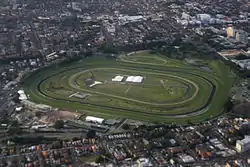
The Queen and The Duke of Edinburgh undertook a royal tour of Australia in February 1992 in order to officiate at celebrations marking the 150th anniversary of Sydney City's Council, during her 40th year as monarch. The Queen officially opened refurbishments to the Sydney Town Hall and also the Paddock Stand at Sydney's Royal Randwick Racecourse, headquarters of the Australian Jockey Club, which also celebrated its 150th anniversary.[26] It was also on this occasion that the Queen certified Randwick as 'Royal'.[27]
The Prime Minister of Australia, Paul Keating, also congratulated The Queen for reaching the 40th anniversary of her accession to the throne.[28] It was also on this occasion, that Prime Minister Keating broke royal protocol by placing his hand on the Queen's back, causing outraged British tabloid newspapers to dub him the 'Lizard of Oz'.[29]
The Royal Ladies Coin and Medallion set
The Royal Australian Mint issued a special commemorative coin set, both in gold and in silver, to mark The Queen's Ruby Jubilee. Titled 'The Royal Ladies', the set consists of four proof twenty-five dollar coins commemorating the 40th anniversary of the accession of Queen Elizabeth II. The reverses portray The Queen Mother, The Princess of Wales, The Princess Royal and The Princess Margaret. The set also includes a medallion.[30]
See also
References
- "The Queen Elizabeth II Equestrian Monument". www.gg.ca. Governor General of Canada. Retrieved 25 November 2020.
- Queen marks Ruby Jubilee
- Miller, Frederica (27 January 2021). "Prince Charles, William and Princess Anne could get new honours from Queen Elizabeth II" – via Daily Express.
- Yeginsu, Ceylan (February 6, 2017). "Queen Elizabeth II's Sapphire Jubilee Takes On Low-Key Tone (Published 2017)" – via NYTimes.com.
- "Annus horribilis speech, 24 November 1992". The Official Website of the British Monarchy. Archived from the original on 2 March 2009.
- Oakley, Nicola (8 October 2018). "The toe-sucking photo that drove Sarah Ferguson out of the royal family". Daily Mirror.
- "Queen Elizabeth II: Britain's longest reigning monarch". BBC Teach.
- "The Queen is about to become the first British monarch in history to reach her Sapphire Jubilee". Evening Standard. January 31, 2017.
- Davies, Caroline (2012-05-24). "How the royal family bounced back from its 'annus horribilis'". The Guardian.
- "History". Government Portal of Mauritius.
- Stanglin, Doug (18 March 2010), "German study concludes 25,000 died in Allied bombing of Dresden", USA Today, retrieved 19 March 2010
- Bongiorno, Frank (1 January 2017). "Cabinet papers 1992-93: Australia moves to make Her Majesty obsolete". The Conversation.
- "PMQT – 6 February 1992". John Major Archive.
- Valentine Low (28 December 2018). "National Archives: Eagle-eyed aide saved John Major from Queen tax gaffe". The Times.
- "Poster Print of Politics - Former Prime Ministers Dinner - Spencer House - 1992". PA Images. 5 January 2009.
- "About the Prizes". The Queen's Anniversary Prizes.
- William E. Schmidt (28 October 1992). "40 Years of Glory in the New Elizabethan Age". The New York Times.
- "Commonwealth Mace 1992". Royal Collection Trust.
- Murphy, Philip (2013). Monarchy and the End of Empire: The House of Windsor, the British Government, and the Postwar Commonwealth. Oxford University Press. p. 288. ISBN 9780191662188.
- "Golden mace "a symbol of The Queen's legacy", says Secretary-General". The Commonwealth. 29 May 2018.
- Jeff Silverman (15 November 1992). "Review: "Elizabeth R: A Year in the Life of the Queen"". Variety.
- James Fallon (16 November 1992). "Prime-time Queen". Sun Sentinel.
- "Public life 1992-2001". The British Monarch.
- Linda Joffee (10 September 1992). "Rare Video Portrait of the Queen". The Christian Science Monitor.
- Bousfield, Arthur; Toffoli, Garry (2002). Fifty Years the Queen: A Tribute to Her Majesty Queen Elizabeth II on Her Golden Jubilee. Dundurn. pp. 200–201. ISBN 9781550023602.
- "Queen Elizabeth, Prince Philip arrive in Australia". UPI. 18 February 1992.
- Racecourse Architecture: Royal Randwick
- "TRANSCRIPT OF THE PRIME MINISTER, THE HON P J KEATING, MP PARLIAMENTARY RECEPTION FOR HER MAJESTY THE QUEEN AND HIS ROYAL HIGHNESS THE DUKE OF EDINBURGH 24 FEBRUARY 1992". PM Transcripts: Transcripts from the Prime Ministers of Australia. 24 February 1992.
- "No hands, ma'am: Australian prime ministers meet the Queen – in pictures". The Guardian. 12 July 2017.
- The Numismatist Volume 105 (1992). American Numismatic Association. 1992. p. 945.
